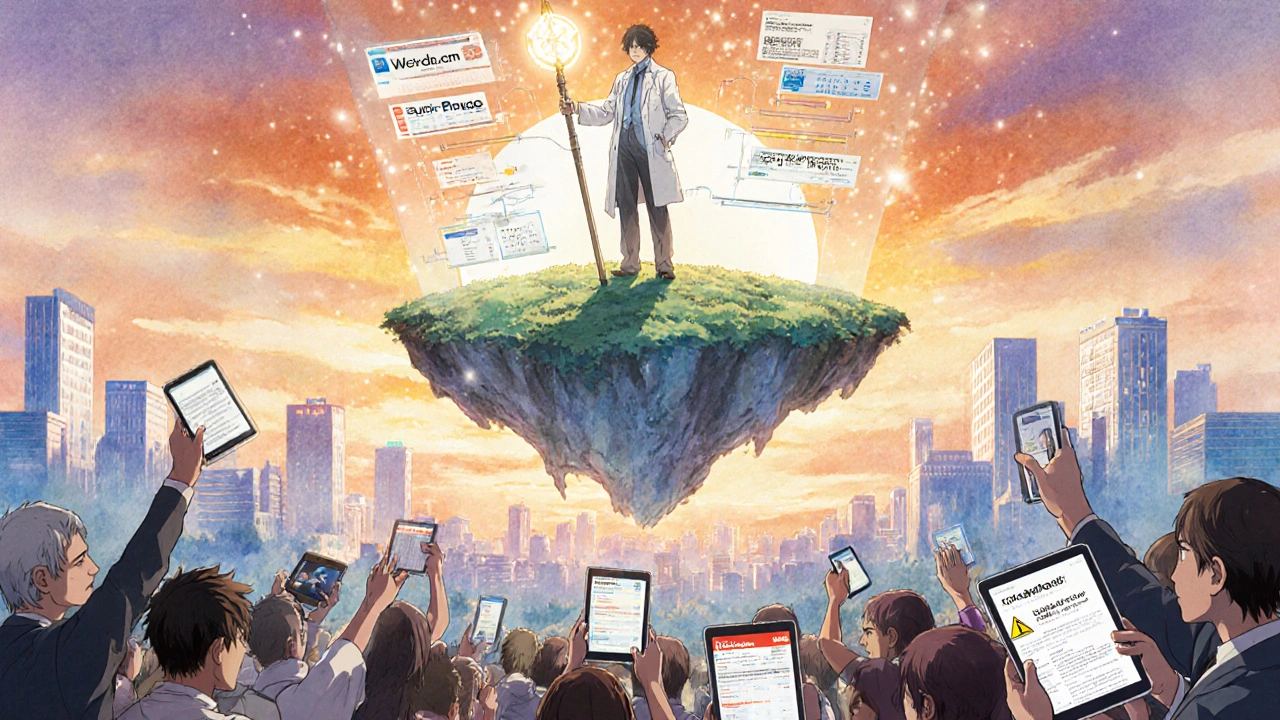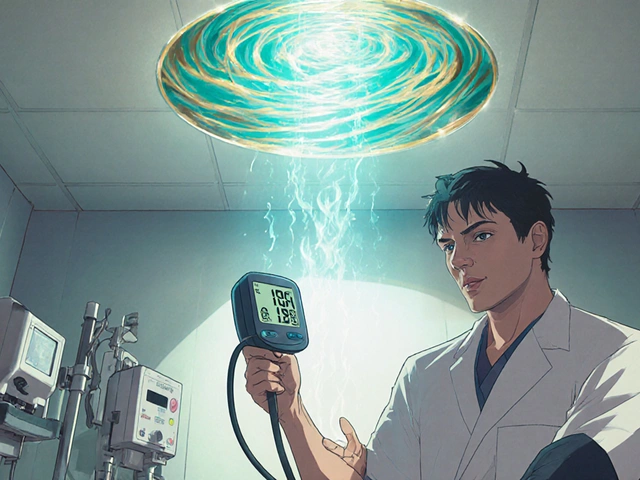Every year, tens of thousands of people end up in the hospital because of unexpected reactions between their medications. It’s not always a mistake by the doctor or pharmacist. Often, it’s because someone didn’t check what happens when they take their blood pressure pill with their ibuprofen, or their fish oil with their antidepressant. That’s where a drug interaction checker comes in - but only if you use it right.
What a Drug Interaction Checker Actually Does
A drug interaction checker is a digital tool that scans your list of medications and warns you about possible conflicts. It doesn’t guess. It compares each drug against a database of known interactions - things like how one drug can make another less effective, or how mixing two can cause dangerous side effects like dizziness, bleeding, or even heart rhythm problems. These tools look at three main types of interactions:- Drug-drug: When two medications affect each other. For example, the antibiotic clarithromycin can spike levels of the cholesterol drug simvastatin, raising your risk of muscle damage.
- Drug-food/drink: Grapefruit juice isn’t just bad with statins - it messes with over 85 medications, including some blood pressure and anti-anxiety drugs.
- Drug-condition: If you have kidney disease, certain painkillers like NSAIDs can make it worse. The checker won’t know your medical history unless you tell it.
Tools like Lexi-Interact, Micromedex, and the University of Liverpool’s COVID-19 DDI Checker use color codes to show severity: red for dangerous, orange for caution, yellow for mild, and green for safe. But not all tools are built the same.
Which Checker Should You Use?
If you’re a patient, you probably want something free and easy. WebMD and Drugs.com offer basic checkers that work fine for a quick scan. But here’s the catch: a 2016 NIH study found that free tools like WebMD and Medscape only catch about 50% of clinically important interactions. Epocrates, popular among pharmacy students, is accurate around 60% of the time. For professionals - doctors, pharmacists, nurses - Lexi-Interact and Micromedex are the gold standards. Lexi-Interact catches more potential problems (77% sensitivity), but it also throws up more false alarms. Micromedex is better at ignoring noise (78% specificity), but might miss something subtle. The University of Liverpool’s tool, updated weekly, is unmatched for checking interactions with Paxlovid (nirmatrelvir/ritonavir), the main COVID-19 antiviral. It’s not for general use, but if you’re on that drug, it’s essential.Here’s how the top tools compare:
| Tool | Best For | Accuracy | Accessibility | Supplement Coverage |
|---|---|---|---|---|
| Lexi-Interact | Comprehensive screening | 77% sensitivity | Professional EHR only | Good |
| Micromedex | Reducing false alerts | 78% specificity | Professional EHR only | Excellent |
| University of Liverpool DDI Checker | COVID-19 drugs | 98%+ for Paxlovid | Free, public | High (for COVID meds) |
| Drugs.com | Consumers checking OTC/supplements | ~60% | Free, mobile-friendly | Very good |
| WebMD | Quick consumer checks | ~50% | Free, easy | Poor |
| Epocrates | Mobile access | 60.3% | App only | Weak |
Don’t rely on one tool. A 2022 ASHP guideline says to use at least two for high-risk patients. Why? Studies show a 15-20% difference in alerts between major systems. What one misses, another might catch.
How to Use It Correctly (Step-by-Step)
Using a checker wrong is worse than not using it at all. Here’s how to do it right:- Make a full list. Write down every pill, patch, injection, vitamin, herb, and supplement you take - even the ones you only use once a week. Don’t forget OTC stuff like melatonin, zinc, or St. John’s wort. These account for 23% of serious interactions, according to the Cleveland Clinic.
- Use the right tool. If you’re a patient, start with Drugs.com or WebMD. If you’re a healthcare worker, use Lexi-Interact or Micromedex. For COVID-19 meds, go straight to the University of Liverpool’s checker.
- Enter everything exactly. Type in the full generic name: “sertraline,” not “Zoloft.” Some tools accept brand names, but generic is more reliable. For supplements, search by ingredient: “St. John’s Wort,” not “Herbal Mood Support.”
- Focus on red and orange alerts. Most tools flag dozens of interactions. But only 5-10% are truly dangerous. Ignore yellow unless you’re on multiple meds or have kidney/liver disease.
- Check for drug-condition conflicts. If you have heart failure, diabetes, or liver disease, some meds become riskier. A checker won’t know this unless you tell it. Always review your health conditions separately.
- Don’t trust green. Just because a checker says “no interaction” doesn’t mean it’s safe. New drugs, rare combinations, and individual genetics can still cause problems.

What These Tools Can’t Do
Even the best drug interaction checker has limits:- They can’t predict interactions for brand-new drugs. If a medication was approved last month, it’s probably not in the database yet.
- They don’t know your body. Two people taking the same mix might react differently because of age, liver function, or genetics.
- They miss timing. If you take your blood thinner at night and your aspirin in the morning, some tools won’t catch that as a risk - even though it could add up.
- They don’t replace a pharmacist. The FDA says no checker can replace a pharmacist’s review for people on five or more medications.
A 2022 case in the Journal of Patient Safety showed a patient who relied on a free checker that missed a deadly interaction between sertraline and linezolid (an antibiotic). The result? Serotonin syndrome - a life-threatening condition. The tool said “no interaction.” The pharmacist, who knew the patient’s full history, caught it.
Real-World Tips from Pharmacists
Pharmacists in Melbourne, Sydney, and across the U.S. agree on a few things:- “Always bring your full list to your pharmacy visit,” says Sarah Lin, a community pharmacist in Carlton. “I’ve seen people forget their CBD oil or their grandma’s herbal tea. Those are the ones that bite you.”
- “If a checker flags something red, don’t stop the med. Call your doctor or pharmacist. Some interactions can be managed with dose changes,” says Dr. Raj Patel, a clinical pharmacist at St. Vincent’s Hospital.
- “Don’t use Epocrates on your phone in a rush. The app crashes if you type too fast. Use Drugs.com on a laptop instead,” says a Reddit pharmacist with 12 years of experience.
And here’s the biggest one: Never assume a checker is 100% accurate. Even the best systems miss 10-15% of interactions. That’s why the NIH says combining two tools and adding a pharmacist’s input gives you the best safety net.

What’s Next for Drug Interaction Checkers
The future is smarter. In 2024, Epic Systems rolled out InteractionGuard, which doesn’t just check what you take - it checks when you take it. If you’re on a blood thinner and take ibuprofen at 8 a.m. and 8 p.m., it flags the timing risk. AI-powered tools are being trained on millions of real-world adverse event reports, not just lab studies. One NIH-funded project in 2023 improved detection by 18% using machine learning.But the core truth hasn’t changed: tools are helpers, not replacements. The more complex your meds, the more you need a human - especially if you’re over 65, taking four or more drugs, or have chronic conditions like diabetes or kidney disease.
Final Rule: Always Confirm With a Pharmacist
A 2023 survey by the National Community Pharmacists Association found that 68% of pharmacists recommend patients use online checkers - but only if they follow up with a professional. That’s not a suggestion. It’s the law of safe用药.Before you take a new medication, combine a drug interaction checker with a quick call to your pharmacy. Even a 2-minute chat can prevent a hospital trip. The tool gives you the question. The pharmacist gives you the answer.
Can I trust free drug interaction checkers like WebMD or Drugs.com?
Free tools like WebMD and Drugs.com are useful for quick checks, especially for over-the-counter meds and supplements. But they’re only about 50-60% accurate in catching serious interactions. They’re great for awareness, not safety assurance. Always cross-check with a pharmacist, especially if you’re on multiple prescriptions.
Do drug interaction checkers catch interactions with herbal supplements?
Some do, some don’t. Drugs.com and Micromedex have strong supplement databases. WebMD and Epocrates are weak here. St. John’s wort, garlic, ginkgo, and kava can interact with blood thinners, antidepressants, and blood pressure meds - and many free tools miss these. Always list supplements by their active ingredient, not brand name.
Why do I get so many alerts on Lexi-Interact?
Lexi-Interact is designed to catch every possible interaction, even minor ones. That means it’s highly sensitive - great for safety, but it creates alert fatigue. About 45% of its warnings are considered clinically irrelevant by pharmacists. Focus only on red and orange alerts. Don’t ignore them, but don’t panic over yellow ones unless you’re on many meds.
Is there a drug interaction checker for COVID-19 treatments like Paxlovid?
Yes. The University of Liverpool’s COVID-19 Drug Interactions Checker is the most accurate and up-to-date tool for Paxlovid (nirmatrelvir/ritonavir). It’s updated weekly with new evidence and flags interactions with over 1,200 medications. It’s free, public, and trusted by hospitals worldwide. Use this one if you’re on Paxlovid - don’t rely on general checkers.
Can a drug interaction checker replace my pharmacist?
No. The FDA and the American Society of Health-System Pharmacists both say no tool can replace a pharmacist’s review, especially for people taking five or more medications. Pharmacists know your full history, your kidney and liver function, your allergies, and your lifestyle. A checker only knows what you type in. Always talk to your pharmacist before making changes.
What should I do if a checker says two of my meds interact?
Don’t stop taking either one. Call your doctor or pharmacist immediately. Many interactions can be managed - by changing the dose, timing the doses apart, or switching to a safer alternative. Stopping a medication on your own can be dangerous. The checker flags a risk - your provider decides what to do about it.
Are drug interaction checkers updated regularly?
Enterprise tools like Micromedex and Lexi-Interact update daily. Free tools update less frequently - sometimes monthly. The University of Liverpool’s tool updates weekly based on new studies. If a drug was approved in the last 30 days, it might not be in any database yet. Always check the tool’s last update date before relying on it.
Why do some doctors say not to rely on these tools?
Some doctors warn against overreliance because these tools can create false confidence. A 2021 study found that 32% of high-severity alerts are for interactions that are theoretically possible but never seen in real patients. If you stop a medication just because a tool flagged it, you might lose a treatment you actually need. Always use the tool as a starting point, not the final word.
Next Steps
If you’re taking more than three medications, do this today:- Write down every pill, vitamin, and herb you take.
- Go to Drugs.com or the University of Liverpool’s checker (if on Paxlovid).
- Enter everything - no exceptions.
- Take the results to your next pharmacy visit and ask: “Which of these are real risks?”
That’s it. No fancy apps. No expensive software. Just a list, a tool, and a conversation. That’s how you stay safe.






Alexis Paredes Gallego
18 November, 2025 . 18:50 PM
So let me get this straight - you’re telling me the government and Big Pharma don’t want us to know that these ‘interaction checkers’ are just glorified spam bots trained on data from 2012? I checked my blood pressure med against my turmeric supplement on Drugs.com… and it said ‘green.’ But my cousin’s neighbor’s dog groomer’s uncle who works at the FDA told me they’re all lying to us to sell more pills. And now I’m not even sure if water is safe with my vitamins anymore. 😈
Saket Sharma
20 November, 2025 . 09:53 AM
Baseline clinical efficacy of consumer-facing DDI tools remains suboptimal (50–60% sensitivity). Lexi-Interact and Micromedex demonstrate superior PPV and NPV in EHR-integrated settings. Supplement pharmacokinetics are grossly underrepresented in open-access platforms - a critical gap in polypharmacy risk stratification.
Shravan Jain
21 November, 2025 . 07:08 AM
It’s funny… we’ve outsourced our intelligence to algorithms… and then wonder why we’re so sick. The checker doesn’t know your soul. It doesn’t know you cried last week because your mom’s meds cost $800. It doesn’t know you skipped breakfast to afford your insulin. A tool can’t measure suffering… only data points. And yet… we treat it like a god. We’re not patients anymore. We’re inputs. And the system? It’s just running code.
Brandon Lowi
21 November, 2025 . 17:46 PM
Let me just say this - if you’re trusting some app written by a grad student in Bangalore to tell you whether your heart med will kill you… you’re one missed update away from a coroner’s report. America’s healthcare system is a dumpster fire, and these ‘free tools’? They’re just the spark. I’ve seen people stop their anticoagulants because a website said ‘possible interaction’ - and then they ended up in the ER with a clot. That’s not safety. That’s negligence dressed up as convenience.
Richard Couron
23 November, 2025 . 15:24 PM
EVERY SINGLE ONE of these tools is paid for by pharmaceutical companies. You think they want you to know that your antidepressant + OTC cold medicine = cardiac arrest? NOPE. They want you to keep buying. The FDA? They’re on the payroll. The University of Liverpool? Totally legit - but only because they’re funded by the EU to make us look bad. I checked my meds on 7 different sites. All said ‘green.’ Then I called my pharmacist - she laughed and said, ‘You’re lucky you didn’t die last month.’
Alex Boozan
24 November, 2025 . 20:42 PM
There’s a fundamental flaw in this entire paradigm: interaction checkers assume static pharmacokinetics. They don’t account for circadian variation, gut microbiome shifts, or epigenetic expression changes triggered by stress. A ‘red’ alert for sertraline and St. John’s wort ignores that the patient’s cortisol levels may modulate CYP2D6 activity by 40% on any given day. Tools are deterministic. Humans are stochastic. You’re not managing risk - you’re performing digital astrology.
mithun mohanta
25 November, 2025 . 19:44 PM
Look, I get it - you want to feel smart using these tools… but let’s be real: if you’re typing ‘CBD oil’ into Drugs.com and calling it a day… you’re not being proactive, you’re being lazy. And if you think Lexi-Interact is ‘too loud’? Honey, that’s the whole point. It’s screaming because your regimen is a minefield. You want safety? Stop Googling. Stop trusting apps. Walk into a pharmacy. Talk to a human. They’ve seen your type before - and they’re not impressed.
Evan Brady
26 November, 2025 . 19:13 PM
Best tip I’ve ever heard: when you’re on five meds or more, print out your list - every pill, every herb, every drop of tincture - and take it to your pharmacy. Not your doctor. Your pharmacist. They’ll spot things the computer misses - like that you’re taking melatonin with your blood thinner, or that your ‘natural’ energy pill has hidden caffeine. I’ve seen it a hundred times. The checker says ‘green.’ The pharmacist says, ‘You’re gonna pass out on the toilet.’ Trust the human. They’ve got skin in the game.
Ram tech
27 November, 2025 . 20:50 PM
Free tools are useless. Just use Lexi. Or don’t. Whatever.